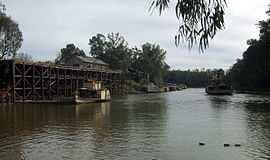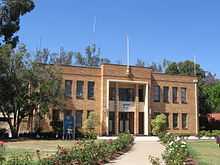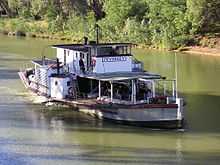Echuca
| Echuca Victoria | |||||||
|---|---|---|---|---|---|---|---|
 Echuca's main landmark, the dock on the Murray River. | |||||||
 Echuca | |||||||
| Coordinates | 36°08′0″S 144°45′0″E / 36.13333°S 144.75000°ECoordinates: 36°08′0″S 144°45′0″E / 36.13333°S 144.75000°E | ||||||
| Population | 12,983 (2011)[1] | ||||||
| Postcode(s) | 3564 | ||||||
| Elevation | 96 m (315 ft) | ||||||
| Location | |||||||
| LGA(s) | Shire of Campaspe | ||||||
| State electorate(s) | Rodney | ||||||
| Federal Division(s) | Murray | ||||||
| |||||||
Echuca (/əˈtʃuːkə/ ə-CHOO-kə)[2] is a town located on the banks of the Murray River and Campaspe River in Victoria, Australia. The Border town Moama is on the northern side of the Murray river in New South Wales. Echuca is the administrative centre and largest settlement in the Shire of Campaspe. At the 2011 census, Echuca had a population of 12,983.[1]
Echuca, an Aboriginal name meaning "Meeting of the Waters" is indicative of the role rivers have played in the town's existence.[3] Echuca is situated close to the junction of the Goulburn, Campaspe and Murray Rivers. Its location at the closest point of the Murray to Melbourne contributed to its development as a thriving river port city during the 19th century.
History
Foundation
Echuca was founded by one of the most enterprising characters of the early colonial days, an ex-convict named Henry Hopwood. In 1850 he bought a small punt which operated across the Murray River near the Campaspe junction. The relatively small settlement known as "Hopwood's Ferry" became Echuca as the town grew. The Post Office known as Hopwoods Punt opened around 1854 and was renamed Echuca on 1 January 1855.[4]
While the settlers at Echuca treated the local Aborigines with relative kindness[citation needed], their way of life was irrevocably changed by their relationship with the Europeans. Having already been decimated by smallpox in the late 1820s, in the 1850s many Aborigines developed a taste for European luxuries such as bread, tobacco and alcohol. They were relegated to the role of fringe-dwellers, living on the banks of the Murray, and occasionally entering into the European economy as fishermen and farm labourers, and by selling the possum rugs which they crafted.
Australia's Inland Port
By the 1870s Echuca had risen to prominence as Australia's largest inland port. Being the point of shortest distance between the Murray River and the major city of Melbourne, Echuca was both a key river port and railway junction. Steam-driven paddleboats would arrive at the 400-metre long redgum Echuca Wharf, unloading it to be transported by rail to Melbourne. Wool, wheat, other grains, livestock and timber were the most common cargoes. The wharf has been listed as a Heritage Place on the Australian National Heritage List.
This industrial boom led to a rapidly expanding population, at one stage in excess of 15,000, with more than a hundred pubs (hotels) rumoured to exist in the Echuca district at one time. An iron bridge was constructed over the Murray River in the 1870s.
Decline
The expansion of the railways from Melbourne to most parts of Victoria, as well as improvements to roads and fickle river conditions all combined to lessen Echuca's importance, and by the 1890s the paddlesteamer fleet was in decline. An economic depression and the collapse of several banks virtually ended Echuca's role as a major economic centre, and her population began to disperse.
Geography
Climate
| Climate data for Echuca RSL | |||||||||||||
|---|---|---|---|---|---|---|---|---|---|---|---|---|---|
| Month | Jan | Feb | Mar | Apr | May | Jun | Jul | Aug | Sep | Oct | Nov | Dec | Year |
| Record high °C (°F) | 45.3 (113.5) |
46.8 (116.2) |
40.5 (104.9) |
36.4 (97.5) |
28.4 (83.1) |
24.4 (75.9) |
24.2 (75.6) |
26.8 (80.2) |
34.0 (93.2) |
38.4 (101.1) |
43.2 (109.8) |
44.6 (112.3) |
46.8 (116.2) |
| Average high °C (°F) | 31.1 (88) |
30.7 (87.3) |
27.3 (81.1) |
22.6 (72.7) |
17.8 (64) |
14.6 (58.3) |
13.6 (56.5) |
15.5 (59.9) |
18.3 (64.9) |
22.0 (71.6) |
26.0 (78.8) |
28.7 (83.7) |
22.3 (72.1) |
| Average low °C (°F) | 15.0 (59) |
15.0 (59) |
12.7 (54.9) |
9.2 (48.6) |
6.4 (43.5) |
4.3 (39.7) |
3.4 (38.1) |
4.4 (39.9) |
6.0 (42.8) |
8.2 (46.8) |
10.9 (51.6) |
13.0 (55.4) |
9.0 (48.2) |
| Record low °C (°F) | 5.0 (41) |
5.8 (42.4) |
1.0 (33.8) |
0.4 (32.7) |
−1.9 (28.6) |
−4.5 (23.9) |
−5.5 (22.1) |
−5.0 (23) |
−1.5 (29.3) |
0.2 (32.4) |
1.3 (34.3) |
0.0 (32) |
−5.5 (22.1) |
| Precipitation mm (inches) | 27.5 (1.083) |
27.0 (1.063) |
31.1 (1.224) |
32.4 (1.276) |
40.0 (1.575) |
42.5 (1.673) |
41.4 (1.63) |
42.4 (1.669) |
38.6 (1.52) |
42.6 (1.677) |
32.8 (1.291) |
29.2 (1.15) |
427.7 (16.839) |
| Avg. precipitation days | 3.9 | 3.7 | 4.6 | 5.9 | 8.3 | 10.3 | 11.5 | 11.4 | 9.5 | 8.3 | 6.0 | 5.1 | 88.5 |
| Source: [5] | |||||||||||||
Governance

Echuca is the administrative centre for the Shire of Campaspe Local Government Area.
At state level, Echuca is represented by the Electoral district of Rodney.
At federal level, Echuca is represented by the Division of Murray.
Economy
The main industry in Echuca is tourism. Tourism injects approximately $250 million into the Echuca economy annually. Visitors are attracted to the town by its warm climate, the Murray River, recreational attractions, and historical features, such as the Port of Echuca which has the world's largest fleet of operating paddle steamers. [citation needed]
Echuca is also a major regional service economy.
Agriculture is very important to the region and dairy, wheat, sheep, pig, and cattle farms are all within close proximity.
Culture
Heritage
Paddle Steamers

The Port is home to the largest Paddle Steamer collection in the world, which includes the world's oldest operating wooden hulled paddle steamer, the PS Adelaide built in 1866. There are several historic vessels operating out of Echuca on a daily commercial basis such as PS Pevensey (built 1911), PS Alexander Arbuthnot (built 1923), PS Adelaide (built 1866) operating from the wharf and the PS Emmylou (built 1980 with a steam engine in use from 1906), PS Canberra (built 1913) and PV Pride of the Murray (built 1924 as a logging barge "C24") operating from Riverboat Dock, a short distance downstream from the main wharf. These vessels conduct between 4-6 1hour cruises daily, while the PS Emmylou offers 1.5hour lunch cruises twice daily and 2 x 1hour cruises daily, and in peak seasons 2-3hour dinner cruising and 1,2 & 3 night accommodated cruises for up to 18 passengers. There are also a number of privately owned paddle steamers in Echuca. As well as the paddle steamers there are numerous houseboats, many of which can be hired. The MV Mary Ann (built 1981) operates as a cruising restaurant in busier times.
The Port of Echuca is also restoring the PS Success to full working order. When operational, it will be added to the fleet of paddle steamers at Echuca Wharf.[6]
Events and Festivals
Annual activities include the Southern 80 waterski race (February) the Jazz, Food and Wine Festival (February) the Rotary Steam Horse and Vintage Rally (June) and the Red Cross Murray Marathon (December).
In Popular Culture
In 1984 the Australian television mini-series, All the Rivers Run, based on a novel by Nancy Cato and starring Sigrid Thornton and John Waters, was filmed in and around Echuca. The local Paddle Steamers PS Pevensey and PS Emmylou featured in the mini-series as the PS Philadelphia and PS Providence respectively. The airing of this series around Australia and internationally revitalised Echuca's tourism economy. In 1985, parts of the Australian telemovie My Brother Tom (based on the book by James Aldridge) was filmed in Echuca.
Transport

Echuca is connected over the Murray River to Moama by the Echuca-Moama Road Rail Bridge. This historically significant bridge has riveted iron spans supported on cast iron pillars.[7]
Echuca-Moama Transit runs 3 services hourly to Echuca East, South & the town of Moama. The terminus is the Old Echuca Post Office on Hare Street. At the moment they are testing a service to 24 Lane and streets on the way to the lane which are near the Rich River Golf Club. V/Line operates the Echuca line rail service from the local station to Melbourne, via Bendigo. Echuca Airport is also located outside the town. [citation needed]
Media
Newspaper
Riverine Herald, produced by McPherson Media Group, is published 3 days a week; it includes local and national news.
Radio
Community radio station, EMFM, broadcasts in Echuca on the frequency of 104.7FM. They currently broadcast at a power of 1 kW.
Television
Television stations such as ABC, SBS, Prime7, WIN and SC Ten as well as digital multi-channels are broadcast into Echuca from other regions.
Retailers
Echuca has many large retailers, including a Big W, Coles, Liquorland, Safeway Supermarket and Liquor (now Woolworths, and BWS), Coles Express, Caltex Woolworths, Mitre 10 Home & Trade, Aldi, Target Country, Dan Murphy's, Dick Smith, Cotton On, The Reject Shop, and Bunnings Warehouse, in addition to the many range of shops such as book shops, music stores, food stores and more.
Sport
The town has an Australian Rules football team competing in the Goulburn Valley Football League[8] and a team Echuca United competing in the Murray Football League.
The most popular participation sport in Echuca is Australian Rules Football and Netball. The local team is called the Murray Bombers. Association Football, or soccer and hockey are also played.
Echuca has a horse racing club, the Echuca Racing Club, which schedules around twelve race meetings a year including the Echuca Cup meeting in March.[9]
Echuca Harness Racing Club conducts regular meetings at its racetrack in the town.[10]
Golfers play at the Echuca Back Nine Golf Course on Eyre and McKenzie Streets.[11]
Water Sports:
- Swimming: Echuca Swimming Club. 50 meter indoor pool. YMCA Echuca War Memorial Aquatic Centre.
- Canoeing: Echuca-Moama Canoe Club and Inland Outriggers.
- Waterskiing: The Southern 80 Ski Race held in February finishing line is in Echuca, starting at the Torrumbarry Weir. Established almost 50 years ago the race is held by the Moama Water Sports Club. The Southern 80 has become iconic with the 2 day event attracting more than 80,000 visitors to the area.
In 2006 the Inaugural Barry Beehag race was established in honour of Barry Beehag, a founding and life member of the Moama Water Sports Club.[12]
Notable people
- In 1970, Echuca resident Leith Ratten was convicted of murdering his wife. His case became one of the most controversial in Victorian legal history.
- Actor/Model Travis Fimmel is from the town.
- AFL footballer Andrew Walker (Carlton)
- AFL footballer Daniel Connors (Richmond)
- AFL footballer Sam Sheldon (Brisbane)
- AFL footballer Jordan Williams (Hawthorn)
- AFL footballer Oliver Wines (Port Adelaide)
- AFL footballer Jack Viney (Melbourne)
Sister City
Echuca's sister city was Whitehorse, Yukon, Canada.[13] However, Whitehorse City ceased the special relationship in 2008.[14]
References
- ↑ 1.0 1.1 Australian Bureau of Statistics (31 October 2012). "Echuca (Statistical Local Area)". 2011 Census QuickStats. Retrieved 2013-11-01.
- ↑ Macquarie Dictionary, Fourth Edition (2005). Melbourne, The Macquarie Library Pty Ltd. ISBN 1-876429-14-3
- ↑ "Where our community names were derived from". Official website. Shire of Campaspe. Retrieved 2007-11-14.
- ↑ Premier Postal History, Post Office List, retrieved 2008-04-11
- ↑ "Climate statistics for". Bureau of Meteorology. Retrieved 20 January 2014.
- ↑ "P.S. Success". Port of Echuca. Retrieved 22 May 2012.
- ↑ http://www.rta.nsw.gov.au/cgi-bin/index.cgi?action=heritage.show&id=4301047
- ↑ Full Points Footy, Echuca, retrieved 2008-07-25
- ↑ Country Racing Victoria, Echuca Racing Club, retrieved 2009-05-07
- ↑ Australian Harness Racing, Echuca, retrieved 2009-05-11
- ↑ Golf Select, Echuca Back Nine, retrieved 2009-05-11
- ↑ http://www.southern80.com.au/History/BarrieBeehag/BBhistory.htm
- ↑ Oke, Chris (June 21, 2008). "Australians surprised by sister city snub". Yukon News. Retrieved 8 September 2013.
- ↑ Oke, Chris (June 7, 2008). "Whitehorse dumps two sister cities". Yukon News. Retrieved 8 September 2013.
External links
| Wikimedia Commons has media related to Echuca, Victoria. |
- Echuca Moama Visitor Information Website
- Official Visitors Information for Echuca and its twin city Moama
- Echuca Wharf – Australian National Heritage listing
| |||||
| |||||||||||||||||
| |||||||||||||||||||||||||||